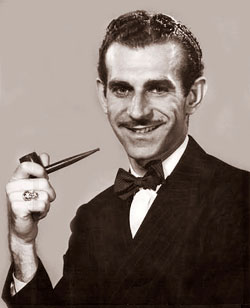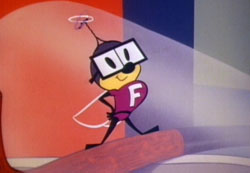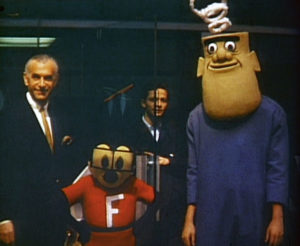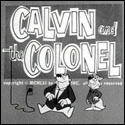
Growing up, I was a big fan of The Addams Family and The Munsters television programs. It mixed horror with humor, a safe place for kids to venture. I was a fan of The Milton the Monster Show, too, which was in production before either of the live-action shows appeared on TV.

Hal Seeger
Hal Seeger Productions, the studio that brought Milton to life, was a blip on the radar in animation history.
After producing Batfink, created shortly after Milton, Seeger threw in the towel concerning the production of animated television series. Seeger said it was a rat race, and too expensive, noting he lost $125,000-$130,000. Over the following decades, he made that loss back many times over, but he didn’t step back into it.
The Milton the Monster Show was not the original intention for the series. Seeger and crew produced three Fearless Fly adventures to pitch The Fearless Fly Show to network television. In the third episode, a recurring nemesis named Professor Weirdo creates a monster named George. Everyone at the studio flipped over the concept and overnight it developed into The Milton the Monster Show.
 Fearless Fly now would appear as one of several short cartoon series appear in the 30-minute show, along with Flukey Luke, Stuffy Durma, Muggy-Doo and Penny Penguin.
Fearless Fly now would appear as one of several short cartoon series appear in the 30-minute show, along with Flukey Luke, Stuffy Durma, Muggy-Doo and Penny Penguin.
The original three Fearless Fly cartoon shorts were added midway into the series to appear as crossovers. But they are in fact a display of the genesis of Milton. Professor Weirdo alone appears in the first, he and Count Kook in the second, and the pair with pre-Milton character George, and early likenesses of Heebie and Jeebie.
Created before Political Correctness came to modern culture, “The Milton the Monster Show” and all its secondary cartoons presented stereotypes lampooning various cultures and delved into séances, curses, suicide, and gunplay.

Milton as “George” in his first appearance
In one Fearless Fly cartoon, Dr. Goo Fee makes a statement that all flies “look alike to me.” Flukey Luke’s faithful Native-American companion is called a “Red Skin.”
 Hal Seeger’s animated creations featured real stories and surprises. You could say many of them were quite clever and had the feel of a situation comedy. Seeger also presented characters that were likable, not just in temperament, but in design and color. You wouldn’t want to meet Heebie and Jeebie in an alley, but they were pretty cool.
Hal Seeger’s animated creations featured real stories and surprises. You could say many of them were quite clever and had the feel of a situation comedy. Seeger also presented characters that were likable, not just in temperament, but in design and color. You wouldn’t want to meet Heebie and Jeebie in an alley, but they were pretty cool.
Often at war with each other, Seeger also presented an environment where everyone could co-exist, even if they didn’t always agree. At the end of the day, everyone still played and stayed together.
I was the age of 8 when Milton first appeared on TV, and became a fan instantly. I even learned to draw Milton, and Heebie and Jeebie, giving illustrations to my classmates at school.
Presently the complete series on DVD is out of print. Hopefully, it will be reissued soon. There’s a cemetery atop Horror Hill, and it’s time to exhume the old gang and bring them all back to life for a new generation to enjoy. For now, I hope you’ll enjoy my latest Cartoon Research mini-book.










































Over across the pond, Cosgrove/Hall took Milton’s concept and made it even sillier with Count Duckula ..
Count Duckula is a social satire about the British. You have a nation with an ancient history of horror, and someone who wants to plunge back into that history. You have the modern heir with a Mid-Atlantic accent, an infantile sort who loves watching TV and whose dearest wish is to sell his castle and break into show business. And then you have another servant, a clueless creature who pampers the heir with every modern comfort and gives him sweets and fluffs his pillows. The show has a low opinion of all three characters, but it loves them just the same.
At last! I’ve always suspected Fearless Fly was created first,and almost had his own show. I do think highlighting Milton was a better choice.Also got a kick out of the Muggy-Doo and Stuffy Derma cartoons,as well.
I get this confused with John Stanley’s “Melvin Monster.” It’s also reminiscent of Dick Briefer’s comedic take on “Frankenstein” in premise, albiet that gentle monster’s creator dies and in short order.
Possibly the last time I watched Milton The Monster was the last time it was originally broadcast. I don’t remember much except a couple characters in general, but I remember watching it regularily and enjoying it. I have warm memories of this show I don’t remember. I’ll revisit it sometime and see if my 6 year old tastebuds were right.
Hal Seeger Productions did do one more animated project which was the 1972 “ABC Saturday Superstar Movie”, “The Man Who Hated Laughter” starring the King Features Syndications characters (including “Beatle Bailey” and “Hi and Lois” whose creator,Mort Walker, just passed away today).
Don’t forget Jim Tyer and Myron Waldman did some animation on this show.
Also, Hal Seeger produced “Out Of The Inkwell” updated Koko the Klown series around 1960 in color.
Milton the Monster was the pioneer of the “Kooky Spooky” style of animation which includes The Groovy Goolies, Drak Pack, Funnybones from Wales, The Trap Door from England, Kaibutsu-kun from Japan, the lame and forgotten Dingbat and the Creeps which was part of the first season of Ruby-Spears’ Heathcliff – and most recently Disney Junior’s Vampirina.
MILTON was certainly different — its offbeat humor and idiosyncratic Seegar design made it stand out from the other shows on (already H-B dominated) Saturday morning. It’s funny to consider, as Kevin Scott Collier notes, that MILTON was coincidentally in the works when THE MUNSTERS and THE ADDAMS FAMILY were given the green light. Kids have always been monster crazy, but this phenomenon was at its zenith in the mid-’60s.
I purchased the Shout! Factory boxed set when it came out, and I was pleased to note that the show was indeed imaginatively designed and rather charmingly animated. It has a style all its own. [Memory does not always serve in these cases — revisiting some well remembered ’60s shows can prove a little depressing, as a few programs simply weren’t really very good at all. It was nice to note that MILTON still held up.]
The Milton shorts are bizarre and lovable. So appealingly odd. I don’t think there was ever anything else on Saturday mornings remotely like Stuffy Derma! Muggy-Doo was clearly an example of taking an idea a little further than absolutely necessary, but it played better than that may sound. Fearless Fly had a lot of kid fans, and the character probably could have easily fronted its own show when Saturday a.m. began to be dominated by superhero shows in ’66 and ’67. [I wonder whether Seegar was ever approached by ABC to discuss such a program?]
I was surprised that the show was never much syndicated after the late ’60s. It had a timelessness (well, monsters are timeless) to it. When I got the boxed set, it was immediately clear why the program hadn’t been seen much in the past thirty years; the Dr. Goo Fee character, Fearless Fly’s usual antagonist, is way too stereotyped to pass muster with modern programmers.
The bit of film included on the boxed set of the visit of a live-action Milton and Fearless Fly to the ’65 Toy Fair (I’m guessing that’s the source of the photo above) is priceless. A shame that the promotion didn’t work, or at any rate, I never saw any Seegar merch — I believe a lot of kids would have wanted little Milton and Fearless toys!
Seeger was not one to do grandiose merchandising which probably explains why he took a loss on some of his shows. As I understand it, when Batfink was on the air, the only merchandise that there was was a Halloween costume. And that was it.
I still remember the tune and some of the words to the theme song.
Whenever I see someone with gigantic eyeglasses, I often say “Fearless Fly!” Sadly, few people get the reference.
Good grief! Are you trying to make me feel old?
I remember “Fearless Fly” appearing as the middle cartoon in “King Kong” for a while; maybe trading places with “Tom of “T.H.U.M.B.” Even then it struck me as odd, as the shows shared a network but nothing else.
Am I alone in recollecting this?
I know it doesn’t make sense — there was no link between Seeger’s company and Rankin-Bass/Videocraft other than both shows aired on ABC — but I also remember this happening at least once. In retrospect, it seems hard to imagine — couldn’t Videocraft have simply inserted an older “TOM of T.H.U..M.B.” segment if a new one wasn’t ready? But I do dimly recall this.
They are different studios BUT I recall seeing Tom Of T.H.U.M.B on its own in one of those kiddies’ host shows, with other cartoons. So…IF they were packaged individually, outside of its original part of the show, it is possible they may have been shown together?
Added the book for further reading to the Wikipedia entry.
Thank you, Dana!
Interestingly it’s the tunes for each ‘mini’ episode of cartoons the comprised the ‘Show’ which I remember most clearly. Not bragging but I have 12 tertiary qualifications including two Masters, one in theology and one in linguistics and when ever a certain demographic gather for a cup of tea at the College and I start – six cups of essence of terror, 12 spoons of sinister sauce – at least one ‘someone else’ will complete the lyrics. I don’t spend all of my time revisiting matters juvenilia but it can be fun.
Professor Weirdo made Milton from a vat of Chemicals(Six Drops Essense o Terror, Five Drops of Sinister Sauce)and that Tincher of Tenderness(Count Kook bumps his Elbow with the Tray dumps in the whole Bottle Milton was born his first words HELLO DADDY